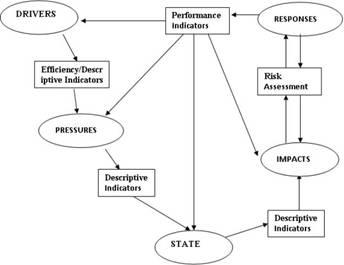Classification of indicators
Many authors (O' Connor, 1994; Pieri et al., 1995; SCOPE, 1995; Dumanski & Pieri, 1996) considered that classification of indicators must take into account the linkages between; (a) pressures exerted on the environment by human activities, (b) changes in quality of the environmental components, and (c) societal responses to these changes that can be a useful and valuable tool for land-users and policy makers. In this sense, the DPSIR framework (Driving forces, Pressure, State, Impact, and Response) has been proposed (Fig. 1). In this scheme indicators can be briefly delineated as a chain reaction process starting from a developmental effort of natural resources, which applies Pressures and Driving forces on the system, changing consequently the State of the system. Such a change produces Impacts, which leads to Responses that by a feedback loop interact with the Driving forces, the Pressures, the State and the Impacts. In this regard, the policy makers need information for all the steps in the presented framework. The vehicles that may convey and reflect such information are indicators.
The DPSIR framework may be utilized as representing the interrelations and their sequences among the initial condition of the system, its transformation and the resulting conditions eliciting from Impacts and Responses. According to their structure, indicators may be grouped in the four major categories demarcated as follows: Descriptive, Performance, Efficiency, and Total Welfare Indicators. Figure 2 is representing the indicators categories that link the various DPSIR elements. Descriptive indicators present the existing conditions, the context of system elements or issues in relation to the principal characteristics (time, geographical local, etc.) through which such elements may be expressed. They may be Driving forces, Pressure, State, Impact, or Responses indicators.
In this context, driving forces indicators may delineate the economic, social and demographic conditions in a given time frame of a certain area. Such indicators also present the resulting changes in production, life styles and consumption. In this regard, the principal driving forces are population growth and the changes in economic and social modes. Such driving forces are creating the corresponding changes in consumption and production. Thus, according to the DPSIR chain these driving forces are applying pressure to the system.
Pressure indicators usually express changes in the use of natural resources (water, land, minerals), biological and natural agents, emissions etc. Therefore, the pressures applied by the economic and social frame and practices to the physical system are resulting to the induced changes in the system elements.

Fig. 1. DPSIR framework for system conditions used for classifying indicators (EEA, in Gentile, 1998).
State indicators demarcate the status of various parameters in a given local situation. They may present biological parameters (wildlife resources, fish stocks etc.), chemical parameters (nitrogen, phosphorous concentrations in the soil or in water bodies etc.), or the quality and quantity of natural parameters (rain, temperature etc.). Impacts indicators are describing the impacts provoked by the changes of the state of the system. Impacts are generated on resources availability, biodiversity, economic relationships, social functions etc.

Fig. 2. DPSIR elements and related indicators (EEA, in Gentile, 1998)
Responses indicators are associated with and describe applied measures by societal groups or institutional organizations to confront, overcome, predict and prevent, compensate and adapt to the transformations of the state of the system. In addition responses indicators are delineating policy measures to preserve certain desirable system features. Such features may lead to "negative driving forces", since their objective is to relieve the pressure and not to cause changes in the state of the system. In this project indicators are distinguished in the categories related to: (a) the physical and ecological environment including climate, soil, water, vegetation, water runoff, fires; (b) the economics including agriculture, cultivation, husbandry, land management, land use, water use, tourism; (c) social; and (d) infrastructure.